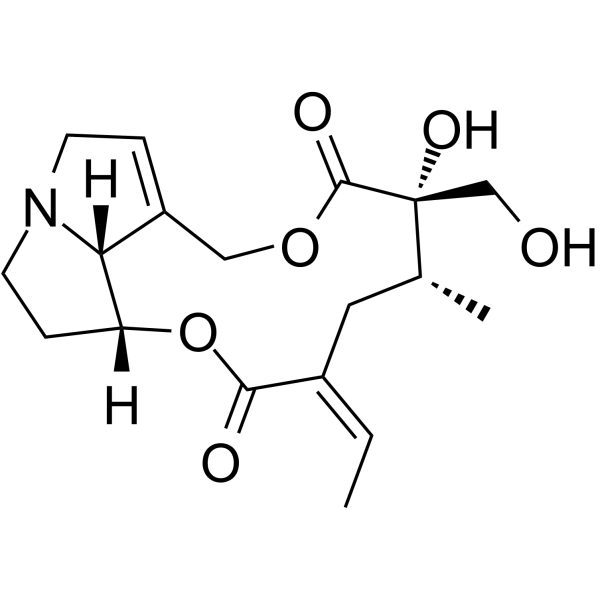Home
Products
Retrorsine



| Product Name | Retrorsine |
| Price: | Inquiry |
| Catalog No.: | CN01479 |
| CAS No.: | 480-54-6 |
| Molecular Formula: | C18H25NO6 |
| Molecular Weight: | 351.40 g/mol |
| Purity: | >=98% |
| Type of Compound: | Alkaloids |
| Physical Desc.: | Powder |
| Source: | The herbs of Senecio scandens |
| Solvent: | Chloroform, Dichloromethane, Ethyl Acetate, DMSO, Acetone, etc. |
| SMILES: | C/C=C1/C[C@@H](C)[C@](O)(CO)C(=O)OCC2=CCN3[C@H]2[C@H](OC1=O)CC3 |
| Contact us | |
|---|---|
| First Name: | |
| Last Name: | |
| E-mail: | |
| Question: | |
| Description | Retrorsine is a naturally occurring toxic pyrrolizidine alkaloid. Retrorsine can bind with DNA and inhibits the proliferative capacity of hepatocytes[1][2]. |
| In Vitro | Retrorsine (60-240 μM; 24 hours) significantly reduces HSEC-CYP3A4 cells viability, depletes GSH, and increases formation of pyrrole-protein adducts[3]. Cell Viability Assay[3] Cell Line: HSEC-CYP3A4 cells Concentration: 60 μM, 120 μM , 240 μM Incubation Time: 24 hours Result: Significantly decreased cell viability. |
| In Vivo | Retrorsine (30 mg/kg; i.p.; twice) impairs liver regeneration in the PBL model not only by an S or G2/M phase block, but also by a block located before the G1/S transition of the cell cycle[1]. Animal Model: Male Wistar rats (180±20 g), portal branch ligation (PBL) model[1] Dosage: 30 mg/kg Administration: Intraperitoneal injection, twice, separated by 2-week interval Result: Strongly impaired the liver weight gain, protein and DNA synthesis as well as induction of cell cycle related proteins in the regenerating lobes after PBL. |
| Density | 1.3±0.1 g/cm3 |
| Boiling Point | 583.2±50.0 °C at 760 mmHg |
| Flash Point | 306.5±30.1 °C |
| Exact Mass | 351.168182 |
| PSA | 96.30000 |
| LogP | -0.14 |
| Vapour Pressure | 0.0±3.7 mmHg at 25°C |